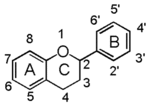Category:FL
FL: Flavonoid
Structural Characteristics
Flavonoid is a class of plant secondary metabolites that have two benzene rings (each called A-ring and B-ring) connected by a chain of three carbons (Figure 1).The carbon chain, corresponding to the numbers 2,3,4 in Figure 1, is linked to a hydroxyl group in the A-ring to form the C-ring. The class of flavonoids are usually determined by the modification pattern of the C-ring (Table 1).
| FLx | FLxy | ||
|---|---|---|---|
| FL1 | Aurones and Chalcone | FL1A | Aurone |
| FL1B | Auronol | ||
| FL1C | Chalcone | ||
| FL1D | Dihydrochalcone | ||
| FL2 | Flavanone | FL2F | Flavanone |
| FL3 | Flavone | FL3F | Flavone |
| FL4 | Dihydroflavonol | FL4D | Dihydroflavonol |
| FL5 | Flavonol | FL5F | Flavonol |
| FL6 | Flavan | FL6F | Flavan |
| FL63 | Flavan 3-ol | ||
| FL64 | Flavan 4-ol | ||
| FL6D | Flavan 3,4-diol | ||
| FL7 | Anthocyanin | FL7A | Anthocyanin |
| FL7D | 3-Desoxyanthocyanin | ||
| FLI | Isoflavonoid | FLIA | Isoflavone |
| FLIB | Isoflavanone | ||
| FLIC | Isoflavan | ||
| FLID | Pterocarpane | ||
| FLIE | Coumestan | ||
| FLIF | Rotenoid | ||
| FLIG | Coumaranochromone | ||
| FLIH | 3-Arylcoumarin | ||
| FLII | 2-Arylbenzofuran | ||
| FLIJ | alpha-Methoxynbenzoin | ||
| FLN | Neoflavonoid | FLNA | 4-Arylcoumarin |
| FLNB | 4-Arylchroman | ||
| FLNC | Dalbergiquinol | ||
| FLND | Dalbergione | ||
| FLNE | Neoflavene | ||
| FLNF | Coumarinic acid | ||
| names | structure | class | description |
|---|---|---|---|
| Aurones and Chalcones |
100px | FL1 | The C-ring is absent (chalcones) or a 5-member ring (aurones). |
| Flavanone | 100px | FL2 | |
| Flavone | 100px | FL3 | |
| Dihydroflavonol | 100px | FL4 | Because many flavonols (FL5) are hydroxylated at their position 3, they form a different category in our classification. |
| Flavonol | 100px | FL5 | |
| Flavan | 100px | FL6 | |
| Anthocyanin | 100px | FL7 | |
| Isoflavonoid | 100px | FLI | |
| Neoflavonoid | 70px | FLN |
Biosynthesis
Flavonoid is synthesized through the phenylpropanoid-acetate pathway in all higher plants. It is responsible for many biological activities including pigments, anti-oxidative or anti-allergic agents, and signaling elements in nodule formation. Some of them are quite familiar in our daily life.
Familiar examples.
anthocyanin (blueberry), isoflavone (soybean), rutin (soba noodle), catechin (tea), flavan-diol (tea), naringeninchalcone (tomato), polyphenol (wine, cacao)
Subcategories
This category has the following 10 subcategories, out of 10 total.
